Explore All
BROWSE BY CATEGORY
Interior
Exterior
Home Essentials
Homeowner Tools
Blogs & Guides
Find a Pro
Book Your Appointment Now
Home Essentials
About Renovize Home
Explore All
BROWSE BY CATEGORY
Interior
Exterior
Home Essentials
Homeowner Tools
Blogs & Guides
Find a Pro
Book Your Appointment Now
Home Essentials
About Renovize Home
Last Updated on October 10, 2025
Upgrading an old gutter system can save you from serious home maintenance headaches. Gutters play a critical role in directing rainwater and snowmelt away from your house, protecting your foundation, siding, and landscaping from water. Worn-out or undersized gutters can lead to issues like basement flooding, rotting fascia boards, mold growth, and erosion around your home. In this, we’ll explain when to consider replacing or upgrading your gutters, how to approach the project (whether DIY or with professional help), and what key information you need from gutter types and materials to cost estimates and maintenance tips. Let’s dive in so you can upgrade your gutters with confidence and keep your home safe from water damage for years to come.
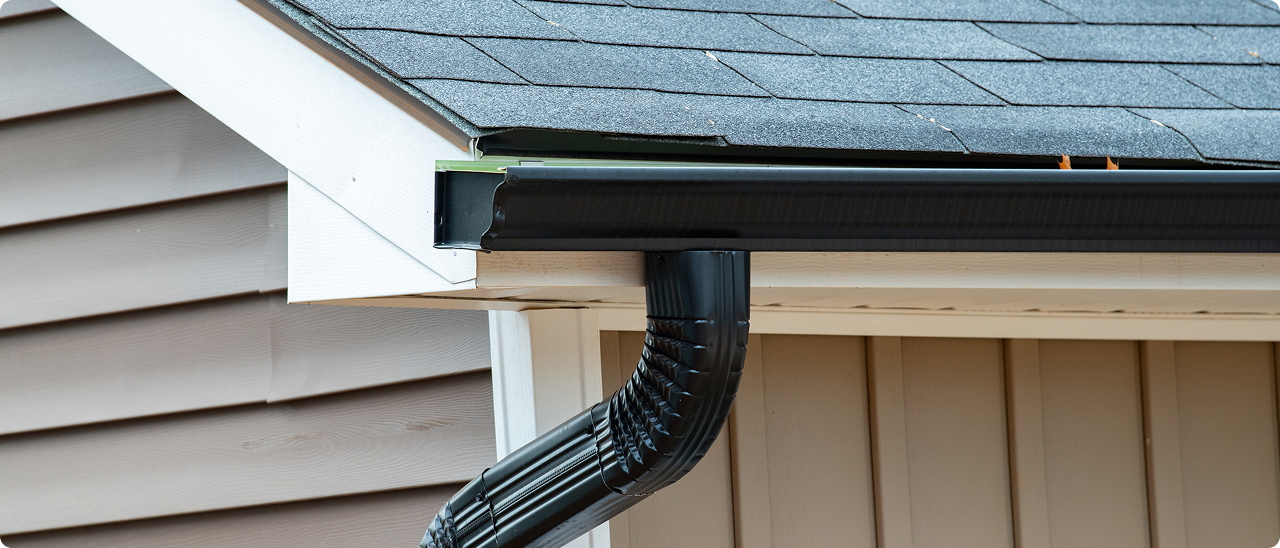
Table of Contents
Why Upgrading Your Gutters Matters
When to Consider a Gutter Upgrade
Choosing the Right Gutter System for Your Home
DIY vs. Professional Gutter Upgrades
Gutter Upgrades and Accessories to Consider
Even though gutters are easy to overlook, they are essential to your home’s well-being. Upgrading a failing gutter system is important because properly functioning gutters:
Gutters collect rainwater from the roof and direct it safely away from the house. This prevents water from cascading directly onto walls or pooling around the foundation, which could cause cracks, leaks, or structural damage over time. In fact, investing in good gutters now can save you from costly repairs later due to rot, foundation settling, or flooded basements.
Without adequate gutters, runoff can spill over and wash away flower beds, erode soil, and splatter mud on your siding. Overflows from clogged or undersized gutters might also damage exterior paint or lead to mildew on walls. Upgraded gutters ensure rain goes where it’s supposed to, into downspouts and safely away from the house keeping your home’s exterior and yard in better shape.
A well-designed gutter system is part of a proactive home maintenance strategy. By controlling water flow, gutters help prevent mold growth, wood rot, and even foundation instability, all of which maintain your property’s structural integrity and value. In some cases, updated gutters can also enhance curb appeal (for example, choosing a color or style that complements your trim).
upgrading your gutters isn’t just about new metal or vinyl on your roofline, it’s an investment in protecting your home from moisture damage. Next, we’ll look at how to recognize when it’s time for a gutter upgrade.
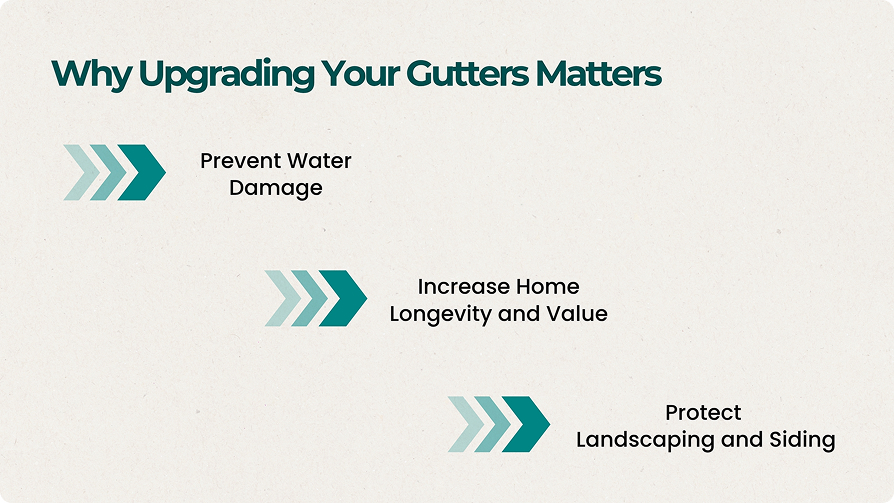
Knowing when to replace or upgrade your gutters is crucial. Gutters don’t last forever, especially if they’ve endured decades of weather. Here are some telltale signs and scenarios that signal it’s time for new gutters:
If you spot cracks or splits in the gutter channels (even small ones), water will leak through and potentially damage the fascia or seep into the house. These openings tend to expand over time. Any section with holes or separated seams should be replaced promptly. In fact, many leaks start at the seams where gutter sections join; upgrading to seamless gutters can eliminate this weak point.
Gutters that appear to sag, bow, or have pulled loose from the eaves are failing to do their job. You might notice them drooping in the middle or detaching from the fascia boards. This is often due to weakened fasteners or heavy clogs adding weight. Sagging gutters won’t catch and channel water properly, so if you see this, it’s time for repair or full replacement before water starts ruining your roof edge or foundation.
During a rainstorm, check if water is overflowing from your gutters or pooling directly below. Overflow can mean the gutters or downspouts are blocked, or simply that the system is undersized or improperly pitched. Frequent puddles near your foundation or water stains on siding are red flags. Overflowing gutters that can’t handle the rainfall volume might indicate you need to upgrade to a larger size or add extra downspouts. Standing water in gutters after rain is another bad sign, it often means the gutter is sagging or the slope is wrong.
Look at the gutter exterior and the area under the eaves. If you notice paint peeling off your house trim or orange rust streaks on steel gutters, it could be due to continuous water overflow or leakage. Peeling paint on the fascia can mean the gutter has been spilling over and keeping the wood damp. Similarly, rust patches on metal gutters show they are corroding and near the end of their life. New gutters (especially aluminum or vinyl options) will be rust-proof.
If you’ve had to reattach hangers, patch leaks multiple times, or you keep finding nails/screws on the ground that have fallen out (a sign of gutters loosening), the gutter system may be beyond simple repair. Continuously fixing gutters can become more expensive over time than installing new ones. At some point, especially if your gutters are 15–20+ years old, it’s wise to stop patching and invest in an upgrade.
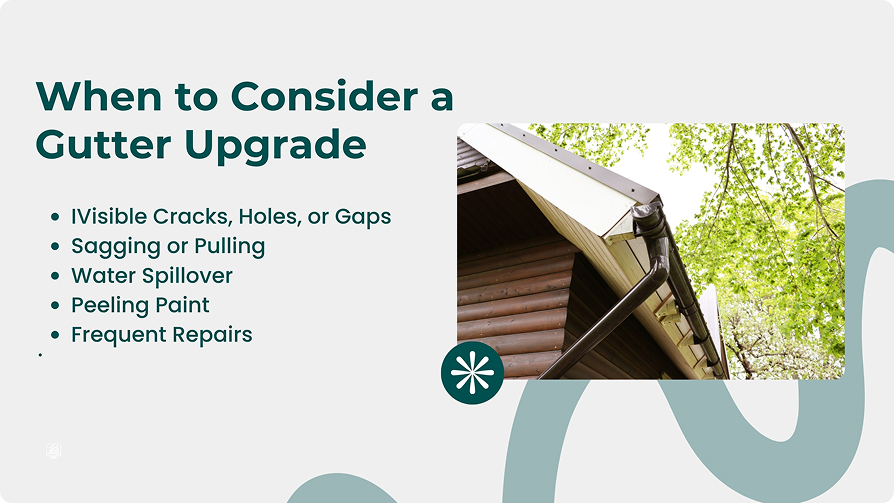
When upgrading gutters, homeowners are faced with a variety of options for materials and styles. The best choice depends on your budget, climate, and aesthetic preferences. In this section, we’ll break down the common gutter materials and design styles to help you make an informed decision.
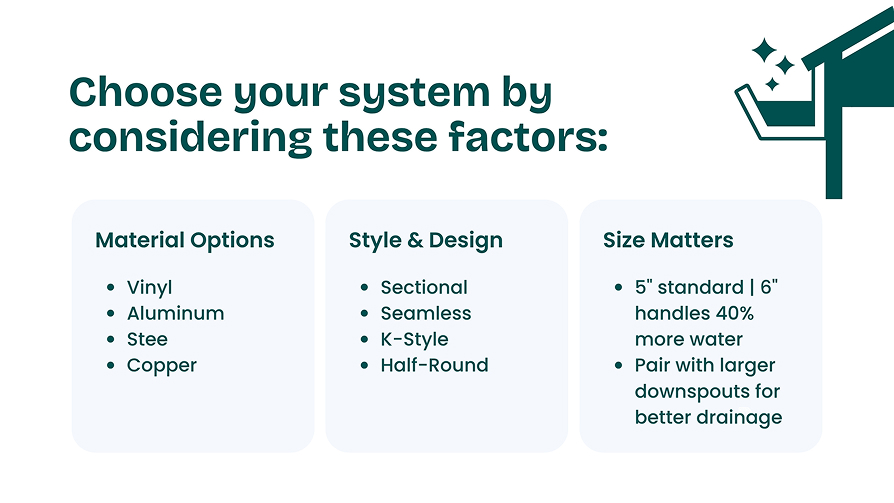
One of the first decisions is what material your new gutters will be made of. The material impacts the cost, durability, appearance, and maintenance needs of the gutters. Here are the most popular gutter materials in the U.S. and what you should know about each:
Besides material, you’ll also choose the style or design of your gutter system. This includes the gutter’s shape/profile, size, and whether you want sectional pieces or seamless installation. Here are some design factors to consider:
Gutters are usually available in 5-inch or 6-inch widths. Upgrading to 6-inch gutters can increase water capacity by 40%, making it a good choice for homes with larger roof areas or areas that experience heavy rainfall. When upgrading, consider also installing larger downspouts (3"x4" vs. 2"x3") to match the increased size. Always consult with a professional to ensure the proper size based on your home's roof pitch and local weather conditions.
Compare options, timelines, and pricing in your area.
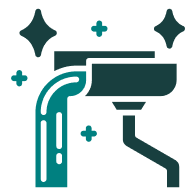
Taking the DIY route can save money on labor and is feasible for small to medium-sized homes, especially for those with basic carpentry skills, while hiring a professional gutter installer ensures expertise, quality work, and convenience. Professionals have the right tools, knowledge, and experience to complete the job quickly and efficiently
If you decide to replace your gutters yourself, you'll need to follow a few steps carefully to ensure proper installation and safety. However, it requires comfort with heights, working on ladders, and managing heavy materials.
Cost to Install Downspouts and Gutters
| DIY Pros | DIY Cons |
|---|---|
| Cost Savings: You save on labor costs, which can reduce the total price significantly. | Safety Risks: Working at heights and with heavy materials can be dangerous without proper precautions. |
| Flexibility: You can work at your own pace, choosing when to start and finish the project. | Time-Consuming: A DIY project can take longer, especially if you’re working on a multi-story home or using complex materials. |
| Learn New Skills: DIY installation provides a hands-on learning experience. | Less Professional Finish: Achieving the perfect slope, sealing seams properly, or handling more complex systems like seamless gutters can be challenging without experience. |
Hiring a professional ensures qualities, expertise & efficient work. This option is ideal for larger or multi-story homes, or if you’re opting for premium materials
Cost to Install Downspouts and Gutters
| Professional Pros | Professional Cons |
|---|---|
| Expert Installation: Professionals ensure gutters are pitched correctly, securely attached, and sealed properly, reducing the risk of leaks. | Higher Cost: Labor costs can be substantial, often accounting for 10% to 50% of the total price. |
| Quick and Efficient: The installation process is faster, usually completed in a day, with minimal disruption. | Less Control: You won’t have as much flexibility as with DIY, and you'll need to schedule the project and work with the contractor’s timeline. |
| Warranty and Insurance: Reputable contractors provide warranties on their work and are insured, giving you peace of mind if accidents happen. | Limited Involvement: You won’t have the hands-on experience or control over every step of the process. |
When upgrading your gutter system, it’s the perfect time to think about any accessories or add-ons that can enhance performance and reduce future maintenance. Here are a few popular gutter upgrades you might include:
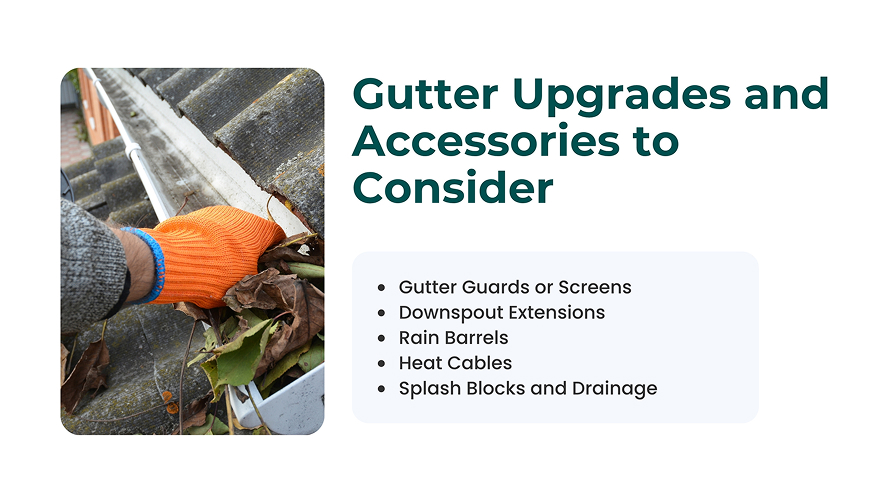
Gutter guards and screens are protective covers placed over or inside gutters to prevent debris from clogging them. Gutter screens are mesh materials that filter out leaves and larger debris, while gutter guards offer a more premium solution with a solid cap that sheds debris. Both reduce the need for frequent cleaning, but still require occasional maintenance. Guards are a bit more costly but are worth it for homeowners with many trees.
Downspout extensions direct water away from your foundation to prevent damage. These can be simple plastic or metal pieces that extend water flow across the yard or more complex solutions like underground pipes. Extensions are affordable and easy to install, but they play a critical role in preventing foundation issues, especially in areas with poor drainage or clay soils.
Rain barrels are a great way to conserve water and use it for gardening. They collect runoff from gutters and store it for later use. Installing a diverter in the downspout allows water to flow into the barrel until full, then bypasses to continue functioning as normal. This is an eco-friendly addition, though barrels must be kept level, covered, and away from standing water to avoid attracting pests.
In cold climates, ice dams can cause gutters to freeze and block water flow. Heat cables, or heat tape, are installed in gutters to melt ice and keep water moving. These cables are connected to a thermostat and activate when the temperature rises above freezing. While not needed for every home, they’re useful for homes prone to ice damming, preventing water backup and gutter damage.
Install splash blocks are simple solutions placed under downspouts to direct water away from your home’s foundation and prevent soil erosion. These can be plastic or concrete pads. For a more permanent solution, downspouts can be connected to French drains or storm drain systems. Ensuring proper water flow away from the house is crucial to avoid potential damage to the foundation.
Most of these accessories can be added later, but it’s smart to address them during the gutter upgrade so that everything works together. For instance, if you’re doing gutter guards, get them installed with the new gutters so you don’t pay for redundant labor. Likewise, have the installer put on downspout extensions or at least drop outlets that make it easy to add extensions.
Upgrading your gutters is more than just a home improvement, it's an investment in protecting your property from water damage. Whether you choose DIY installation, hire professionals, or add helpful accessories like gutter guards or downspout extensions, the key is to act before small issues become costly problems. Don't let poor drainage damage your home-upgrade your gutters and ensure long-lasting protection for years to come.
Yes, you can upgrade your gutter system independently of the roof. Ensure the new system is compatible with your roof's pitch and drainage needs.
Gutter size depends on roof area, local rainfall, and pitch. Larger homes or areas with heavy rainfall benefit from 6-inch gutters and larger downspouts for better water flow.
Yes, heat cables help prevent ice dams by melting snow and allowing water to flow freely through gutters. This is especially useful in cold climates.
If your gutters are still in good condition, replacement isn't necessary. However, consider upgrading them if they are old or damaged to ensure proper drainage with the new roof.
Yes, aluminum and copper gutters are recyclable, making them eco-friendly. Additionally, you can install rain barrels to collect runoff and use it for gardening.
Join our mailing list for exclusive updates, expert tips, and special offers tailored to your needs. Be the first to know about the latest in home services.


Renovize Home is a platform that supports homeowners from planning to renovation. Whether it’s Renovize AI for guidance or a one-on-one call with Pro Finder, we understand your project and match you with local contractors tailored to your needs.
Who We Are
About Renovize HomeGet in TouchHomeownwer Support:
Coming Soon!
General Inquiries:
support@renovizehome.com
Head Office:
24 Greenway Plaza, STE 1800M, Houston, TX 77046.